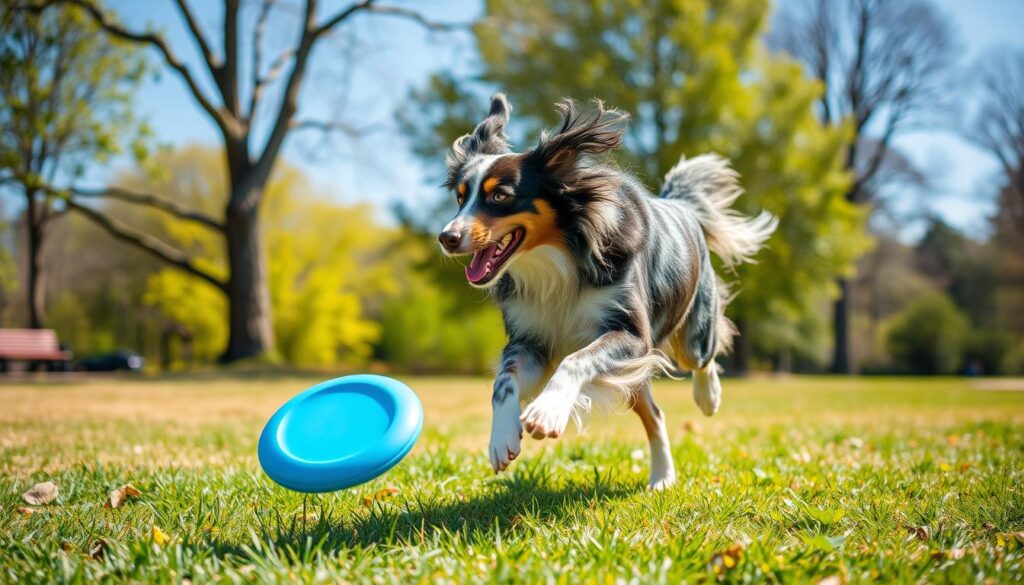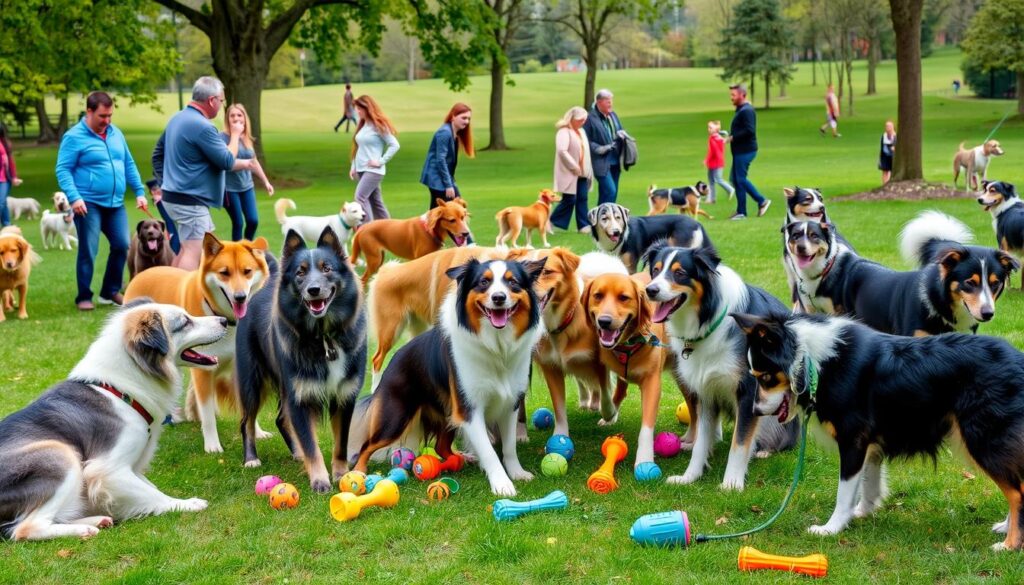The Australian Shepherd Blue Merle is a stunning breed. It has unique coloring and a lively personality. They love to move and think, making them great for active people or families.
These dogs have beautiful blue merle coats. They look amazing but need extra care. Knowing how to groom and train them is important for their happiness.
This guide will help you understand grooming, training, and the Australian Shepherd’s temperament. It’s useful whether you’re getting a new dog or want to improve caring for your current one. Knowing their needs is key to a happy relationship.
Key Takeaways
- The Australian Shepherd Blue Merle needs lots of exercise, at least two hours a day.
- They need regular grooming, especially in spring and fall when they shed a lot.
- Start training and socializing them early for good behavior.
- Good food is important for their health and long life.
- Knowing about health issues helps you care for them better.
- Australian Shepherds are smart and easy to train with consistent practice.
- Understanding their behaviors, like warning barks, helps in training and managing them.
Understanding the Australian Shepherd Dog Breed
The Australian Shepherd is a smart and active breed. They were made for herding animals. They are great as pets, working dogs, and in sports.
They need lots of exercise and fun activities. Without enough, they might get bored and act out. Their energy and love for work make them very loyal to their owners.

Knowing about australian shepherd genetics is key for good breeding. Coat colors and patterns come from genes. For example, merle patterns can affect their health and looks.
Australian Shepherds are 18 to 23 inches tall and weigh 16 to 32 kg. They have a medium-length coat in many colors. Their beauty and kindness make them great friends for families and other pets.
History and Origin of the Blue Merle Australian Shepherd
The blue merle aussie has a rich history from the late 1800s in the United States. They were made for herding livestock. The name “Australian Shepherd” might trick you into thinking they’re from Australia. But, they really come from a mix of herding breeds, especially the Pyrenean Shepherd from the Basque region.
Looking into the australian shepherd breed info, we see they’re known for their beauty and work skills. Farmers loved how smart and fast these dogs were. They helped with herding and became great family pets.

The Australian Shepherd Club of America started in 1957. Over time, breed standards got better, leading to the 1976 unified standards. The American Kennel Club (AKC) recognized them in 1992, making them a part of dog history.
| Year | Event |
|---|---|
| 1957 | Australian Shepherd Club of America established |
| 1976 | Unified breed standards adopted |
| 1980 | Registries combined for a unified record |
| 1992 | AKC grants recognition to the breed |
Now, the blue merle aussie is more than just a herding dog. They’re also loved family pets, keeping their legacy alive.
Physical Characteristics of Australian Shepherds
Australian Shepherds are amazing dogs with cool features. They are 18 to 23 inches tall. Males weigh 50 to 65 pounds, and females weigh 40 to 55 pounds.
These dogs have a medium-length double coat. It comes in many colors. The blue merle australian shepherd has a coat with shades of grey, black, white, and tan.
Another cool thing about them is their eyes. They often have two different colors. This makes them look even more special.
Visible white markings or copper points on their bodies make them stand out. This adds to their charm.
To show the variety of physical characteristics, I’ve made a table:
| Characteristic | Details |
|---|---|
| Height | 18-23 inches |
| Weight | 40-65 pounds |
| Lifespan | 13-15 years |
| Common Colors | Black, Red, Merle, Red Merle, Blue Merle, Tricolor |
| Trainability | Easy to Train |
| Energy Level | High-energy |
Australian Shepherds have cool coat patterns and colors. The blue merle option is especially interesting. Their looks and lively personalities make them great for many homes, even those with kids.

Coat Colors and Patterns: The Beauty of Australian Shepherds
Australian Shepherds are known for their amazing australian shepherd coat patterns and australian shepherd colors. They come in black, blue merle, red, and red merle. The blue merle coat is especially beautiful, with its marbled gray, black, and white.
Some colors are rarer than others. Black Australian Shepherds are rare, and solid black ones are even rarer. Red-coated Australian Shepherds are also rare, with solid red ones being the rarest.
Australian Shepherds have many beautiful patterns. Bicolor coats can be red, black, or blue merle with white markings. Tricolor Australian Shepherds are mostly black tri, but red tri is rarer. Blue merle dogs often have different colored eyes, making them even more special.
Red merle Australian Shepherds have copper and white accents. These can be small speckles or big patches. Red bicolor and tricolor varieties add to the variety, with red, white, and tan or copper highlights.

People love the variety in Australian Shepherd coats. The many australian shepherd colors show the breed’s charm and genetic history. Each Australian Shepherd is unique, making them a joy to own and admire.
The Distinctive Personality of an Australian Shepherd
Australian Shepherds are known for their lively and dynamic nature. They are smart and fun to be around. They love to play and are great with families.

These dogs need lots of exercise to stay happy. They love to run and play. This keeps them from getting bored or misbehaving.
Aussies are friendly with kids, dogs, and even cats. They are very loyal and love to play. This makes them perfect for families with children.
Without enough play and training, they might act out. But with lots of fun activities, they stay happy and well-behaved.
In short, Australian Shepherds are smart, loyal, and full of energy. They make great pets for active families. They love to play and be with their people.
| Characteristic | Description |
|---|---|
| Height | 18 to 23 inches (Average) |
| Weight | 40 to 65 pounds |
| Life Expectancy | 12 to 15 years |
| Energy Level | High, requires daily exercise |
| Temperament | Loyal, intelligent, playful |
Temperament of the Australian Shepherd Blue Merle
The blue merle Australian Shepherd has a special temperament. They are friendly and alert, thanks to their herding roots. They also form strong bonds with their people.
These dogs are very smart. They learn quickly and enjoy training. Positive training and early socialization work best.
They have lots of energy. They need lots of physical activity to stay happy. Without it, they might get into trouble.
They are also protective of their family. They watch over their loved ones carefully. They fit well into active homes.

In short, the blue merle Australian Shepherd is loving and lively. With the right care, they make great family pets.
Activity Level: Keeping Up with Your Aussie
Australian shepherds need lots of exercise every day. They love to walk, run, and play games that make their brains work. If they don’t get enough, they might start to get into trouble.
Playing dog sports or agility training is great for them. It keeps them busy and makes them happy. It also helps us spend quality time together.
They are very smart and love to solve problems. Taking them for runs or to the dog park is good for them. It helps them stay happy and healthy.

Health and Wellness for Your Australian Shepherd
Keeping my australian shepherd health in top shape is a big job. This breed is mostly healthy but can face some health problems. Regular vet visits are key to catch issues early.
Some health issues I watch for include:
- Hip Dysplasia – A common condition that can severely impact mobility.
- Cataracts – Leading to impaired vision, cataracts are among the most frequent eye problems.
- Epilepsy – Canine epilepsy appears occasionally within the breed, although screening tests are limited.
- Autoimmune conditions – Such as autoimmune thyroiditis, make regular health monitoring essential.
- Cancer – Lymphoma and hemangiosarcoma are common types of cancer affecting this breed.
For the best australian shepherd care, I feed my dog high-quality food. They need lots of exercise, at least one to two hours a day. This keeps them physically and mentally fit.
Good grooming is also important for their health. It helps prevent skin problems by keeping their coat clean. Their double coat needs weekly brushing, especially when they shed a lot.

Common Health Issues in Australian Shepherds
As an Australian Shepherd owner, knowing about common health issues is key. Early detection and action can greatly help my dog’s health. Knowing these risks helps my dog live a long, happy life.
Hip dysplasia is a big worry, leading to arthritis if not treated. It’s less common in dogs from healthy parents. Elbow dysplasia is also a concern, though less common.

Eye health is another big area. Progressive Retinal Atrophy (PRA) can cause blindness early. Collie Eye Anomaly (CEA) is also risky, needing vet checks and surgery.
Hearing problems can also happen. Dogs with white ears are more likely to be deaf. Breeding merle dogs together raises deafness risks.
Hypothyroidism and epilepsy are other issues. Hypothyroidism affects weight, and epilepsy needs ongoing meds. Regular vet visits help manage these risks.
| Health Issue | Description | Potential Risks |
|---|---|---|
| Hip Dysplasia | Malformation of the hip joint | Arthritis, mobility issues |
| Progressive Retinal Atrophy (PRA) | Degeneration of retinal cells | Blindness |
| Collie Eye Anomaly (CEA) | Hereditary eye disease | Vision impairment, surgical intervention may be needed |
| Deafness | Lack of pigment in inner ear | Communication challenges |
| Hypothyroidism | Decreased thyroid function | Weight gain, skin and coat problems |
| Epilepsy | Seizure disorder | Medication may be required |
Knowing about these health issues helps me care for my Australian Shepherd better. Regular vet visits and breed-specific care improve my dog’s life a lot.
Nutrition and Diet for Your Australian Shepherd
It’s key to know what your Australian Shepherd needs to stay healthy. They need good proteins, fats, fruits, and veggies. They also need food that gives lots of energy because they are very active.
Each dog is different, so the right amount of food varies. On average, they need about 1.25 cups of dry food twice a day.
Choosing the right australian shepherd diet is important. Look for food made for active dogs. The Honest Kitchen’s Grain Free Beef Clusters is a great choice. It has 427 kCal per cup, 26% protein, and 14.5% fat.
The Honest Kitchen’s Dehydrated Limited Ingredient Fish is also good. It has 34% protein per cup. Both foods give Australian Shepherds the energy they need.
Adding animal fats like chicken fat or fish oil is good. They give lots of calories. Carbs from whole grains or fruits add fiber and nutrients. Sweet potatoes, cranberries, and apples are good for your dog’s health.
Here’s a table showing different dog foods:
| Dog Food Brand | Calories per Cup | Protein Content | Fat Content | Carbohydrate Source |
|---|---|---|---|---|
| The Honest Kitchen Grain Free Beef Clusters | 427 kCal | 26% | 14.5% | Whole Grains |
| The Honest Kitchen Dehydrated Limited Ingredient Fish | Caloric Value Not Specified | 34% | Fat Content Not Specified | Fish |
| The Honest Kitchen Bone Broth Pour Overs (Beef) | 107 kCal | 4.5% | 2.5% | Moisture Rich |

For a balanced diet, avoid foods with bad preservatives, colors, or fillers. Choose foods with natural ingredients. This helps your Australian Shepherd stay healthy and active for a long time.
Grooming Your Australian Shepherd Blue Merle
Grooming an Australian Shepherd, especially the Blue Merle, is key for their looks and health. They have a thick double coat that’s beautiful but needs care. Knowing how to groom them keeps them happy and healthy.
Shedding Patterns and Maintenance
Australian Shepherds shed a bit all year. They shed more in spring and fall. Brushing them weekly helps manage shedding and keeps their coat neat.
Brushing also stops mats and keeps the undercoat in check. This undercoat helps them stay warm, especially for Blue Merles.
Tools and Techniques for Effective Grooming
Using the right tools makes grooming easier. You’ll need:
- Slicker brush for detangling
- Undercoat rake to remove loose hair
- Dog shampoo to maintain coat health
- Nail clippers for regular trims
- Ear cleaner to maintain ear hygiene
Bath them every few months to keep their skin healthy. Use a special shampoo for their undercoat. A blow dryer helps get rid of extra hair and keeps their coat looking good.
| Grooming Task | Frequency | Recommended Tool |
|---|---|---|
| Brushing | Once or twice a week | Slicker brush |
| Bathing | Every few months | Dog shampoo |
| Nail trimming | Every 1-2 months | Nail clippers |
| Ear cleaning | Weekly | Damp cloth or ear cleaner |

Following these grooming tips keeps my Australian Shepherd Blue Merle looking great and feeling good. Regular grooming stops mats and lets me check their skin for health problems.
Training Tips for Australian Shepherds
Training an Australian Shepherd, like the blue merle, needs a good plan. Start training early, from 8 to 16 weeks. This is when they learn best.
Teach them basic commands like “sit” and “down.” Make sure they feel safe in a crate. This is key during their social learning time.
Daily walks and brain games are important. Fun activities, like teaching with a box, keep them interested. Keep training short, 15 to 20 minutes, to keep them focused.
Use rewards like treats and praise to teach them. Clicker training works well too. Break down big tasks into smaller steps for easier learning.
As they grow, join them in AKC activities like agility and obedience. They love these around age one. Watch for skill reminders at 1.5 years.
Stop herding behaviors early. Redirect them to other fun activities. If problems come up, get help from a pro. Tired puppies are happy puppies.

| Training Stage | Age | Goals |
|---|---|---|
| Puppy Stage | 8 – 16 weeks | Basic commands, crate comfort, socialization |
| 6 Months | 6 Months | Daily exercises, reinforcing basic commands |
| One Year and Beyond | 1 Year | Engage in AKC activities like agility and obedience |
Socialization: A Key to Well-Behaved Aussies
It’s very important to socialize Australian Shepherds well. The best time to start is between three and twelve weeks old. Early exposure to different places, people, and dogs helps them a lot.
Walking your dog every day is a great way to socialize them. It lets them see and hear new things. This helps them feel more confident.
When introducing them to new things, do it slowly. Using a muzzle can help with adult dogs. The Online Dog Trainer program has lots of tips for training Australian Shepherds.
Here are some important tips for socializing your Aussie:
| Age Group | Socialization Tips |
|---|---|
| Puppies (3-12 weeks) | Expose them to various people, places, and other dogs. Aim for a diverse range of experiences. |
| Adults | Continue socialization slowly; prioritize calm introductions to new environments. |
| Daily Activities | Incorporate regular walks and visits to pet-friendly locations to enhance social exposure. |
| Behavioral Influences | Remain calm and assertive; your behavior affects your dog’s reactions and comfort levels. |

Good socialization makes Australian Shepherds better at handling different situations. It helps them behave well. By focusing on their social skills, they do great in many places.
Mental Stimulation: Keeping Your Blue Merle Aussie Engaged
Mental stimulation is key for Australian Shepherds. It keeps them happy and stops bad behavior from boredom. I mix up activities every day to keep my dog sharp and joyful.
Walking and playing are musts. My Aussie needs 1-2 hours of fun each day. I add training and agility to make it more fun and strengthen our bond.
Puzzle toys and games are great for their brain. Switching toys keeps them interested and stops boredom damage. Agility training boosts their skills and shows off their natural talents.
| Activity | Benefits |
|---|---|
| Daily Walks | Physical exercise, routine, and bonding time |
| Puzzle Games | Enhances problem-solving skills and mental engagement |
| Agility Training | Boosts athleticism and allows for structured interaction |
| Fetch Games | Encourages playfulness and reinforces training commands |
| Socialization Activities | Helps with adaptation to various environments and other pets |
Using positive methods is important in training. I use clear commands and rewards like clicker training. It teaches them and builds trust.
Fun activities keep my Aussie busy and happy. They prevent problems like too much barking or digging. A lively environment makes my Blue Merle Aussie thrive.

Conclusion
The Australian Shepherd Blue Merle is a lively and devoted friend. They love to be active. Knowing about their temperament, grooming, and training is key.
This summary shows their beauty and need for love and play. It’s important to understand these traits to enjoy our time together.
Caring for these dogs means regular grooming and lots of exercise. They need a good diet and vet visits to live up to 12 to 15 years. Early socialization and training make them happy and obedient.
In short, the Australian Shepherd Blue Merle is a great family pet. They bring joy and energy to our homes. With the right care and training, we can have a wonderful bond with them.
